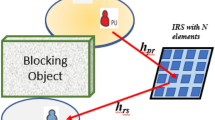Abstract
Due to the environmental noise, variance is uncertain and unknown. The energy-based detection (ED) technology has many shortcomings in cognitive radio. In the paper, an energy-autocorrelation detection (EAD) algorithm is proposed to overcome these challenges, taking advantage of the different characteristics of Gauss white noise and signal. Two statistics are structured based on energy and autocorrelation of samples. This spectrum sensing algorithm can lead to stable and accurate detection performance without any prior information on noise and signal. It is testified in the simulation that the energy-autocorrelation-based detection is much better than energy-based detection; moreover, the impact of some parameters of the algorithm is also simulated and discussed.




Similar content being viewed by others
References
S. Atapattu, C. Tellambura, H. Jiang, Energy detection based cooperative spectrum sensing in cognitive radio networks. IEEE Trans. Wirel. Commun. 10(4), 1232–1241 (2011)
J.C. Clement, K.V. Krishnan, A. Bagubali, Cognitive radio: spectrum sensing problems in signal processing. Int. J. Comput. Appl. 40(16), 37–40 (2012)
A.V. Dandawate, G.B. Giannakis, Statistical tests for presence of cyclostationarity. IEEE Trans. Signal Process. 42(9), 2355–2369 (1994)
N.D. Duong, S.D. Tio, A.S. Madhukumar, A cooperative spectrum sensing technique with dynamic frequency boundary detection and information-entropy-fusion for primary user, detection. Circuits Syst. Signal Process. 30(4), 823–845 (2011)
FCC. Spectrum policy task force report. Report of the spectrum Efficiency Working Group, November 2002
S. Haykin, Cognitive radio: brain-empowered wireless communications. IEEE Trans. Commun. 23(2), 201–220 (2005)
J. Lundén, V. Koivunen, A. Huttunen, H.V. Poor, Spectrum sensing in cognitive radios based on multiple cyclic frequencies, in Proc. 2nd Int. Conf. Cognitive Radio Oriented Wireless Network Communication, Orlando, FL (2007), pp. 37–43
M. Lin, A.P. Vinod, A low complexity high resolution cooperative spectrum-sensing scheme for cognitive radios. Circuits Syst. Signal Process. 31(3), 1127–1145 (2012)
A. Metref, D.L. Guennec, J. Palicot, A carrier recovery loop for cognitive radio applications. Circuits Syst. Signal Process. 30(4), 847–870 (2011)
J. Mitola, Cognitive radio an integrated agent architecture for software defined radio. Ph.D. Dissertation, KTH Royal Institute of Technology, Stockholm, 2000
M. Naraghi-Pour, T. Ikuma, Autocorrelation-based spectrum sensing for cognitive radios. IEEE Trans. Veh. Technol. 59(2), 718–733 (2010)
J. Proakis, in Digital Communications (Publishing House of Electronics Industry, Beijing, 2006), pp. 236–242
R.O. Preda, D.N. Vizireanu, A robust wavelet based video watermarking scheme for copyright protection using the human visual system. J. Electron. Imaging 20(1), 013022 (2011)
R.O. Preda, D.N. Vizireanu, Quantization based video watermarking in the wavelet domain with spatial and temporal redundancy. Int. J. Electron. 98(3), 393–405 (2011)
A. Sahai, R. Tandra, S.M. Mishra, N. Hoven, Fundamental design tradeoffs in cognitive radio systems, in TAPAS (ACM, New York, 2006)
R. Tandra, A. Sahai, SNR walls for signal detection. IEEE J. Sel. Top. Signal Process. 2(1), 4–17 (2008)
Z. Tian, Y. Tafesse, B.M. Sadler, Cyclic feature detection with sub-Nyquist sampling for wideband spectrum sensing. IEEE J. Sel. Top. Signal Process. 6(1), 58–69 (2012)
Z. Tian, G.B. Giannakis, A wavelet approach to wideband spectrum sensing for cognitive radios, in Proc. IEEE CROWNCOM, Mykonos Island, Greece (2006)
H. Urkowitz, Energy detection of unknown deterministic signals. Proc. IEEE 55(4), 523–531 (1967)
R.M. Udrea, D.N. Vizireanu, Quantized multiple sinusoids signal estimation algorithm. J. Instrum. 3, 1–7 (2008)
A.P. Vinod, E.M.-K. Lai, P.K. Meher, J. Palicot, S. Mirabbasi, Guest editorial: special issue on embedded signal processing circuits and systems for cognitive radio-based wireless communication devices. Circuits Syst. Signal Process. 30(4), 683–688 (2011)
D.N. Vizireanu, A simple and precise real-time four point single sinusoid signals instantaneous frequency estimation method for portable DSP based instrumentation. Measurement 44(2), 500–502 (2011)
D.N. Vizireanu, Quantized sine signals estimation algorithm for portable DSP based instrumentation. Int. J. Electron. 96(11), 1175–1181 (2009)
Y. Zeng, Y. Chang Liang, Spectrum-sensing algorithms for cognitive radio based on statistical covariances. IEEE Trans. Veh. Technol. 58(4), 1804–1815 (2009)
Y. Zeng, Y.C. Liang, Maximum-minimum eigenvalue detection for cognitive radio, in Proc. IEEE PIMRC, Athens, Greece (2007)
Y. Zeng, C.L. Koh, Y.C. Liang, Maximum eigenvalue detection: theory and application, in Proc. IEEE ICC, Beijing, China (2008), pp. 4160–4164
Author information
Authors and Affiliations
Corresponding author
Rights and permissions
About this article
Cite this article
Zhou, Y., Zhou, Z. & Zhang, S. An Improved Spectrum Sensing Method: Energy-Autocorrelation-Based Detection Technology. Circuits Syst Signal Process 32, 273–282 (2013). https://doi.org/10.1007/s00034-012-9451-9
Received:
Revised:
Published:
Issue Date:
DOI: https://doi.org/10.1007/s00034-012-9451-9




